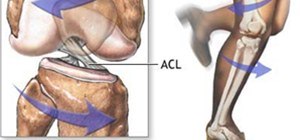The sudden deceleration, shifting in the knee, popping sound and screaming from the intense pain that immediately follows is becoming increasingly common among our young athletes. Those who have witnessed or suffered a torn anterior cruciate ligament (ACL) are familiar with the pain, surgery and intense 6 to 8 month rehabilitation that accompanies the injury, not to mention the disappointment of ending a season. Nationwide, this will occur more than 500,000 times this year, and female athletes with ACL injuries outnumber males 5 to 7 to 1.
Why is this injury more common in female athletes, especially basketball and soccer players? What is it about young female athletes that puts them at such a high risk for this devastating injury?
Several factors contribute to this trend. ACL injuries in females and the biodynamics involved are among the most widely studied topics in sports medicine. Through this research, we have learned that boys and girls differ in many ways beyond those typically considered.
Anatomic Differences
Females have wider hips than males, which increase the angle on the knee joint. The knee was designed as a hinge joint that is supposed to rock forward and back in the frontal plane. Females' wider hips create an inward-directed inward angle on the knee, which causes it to roll side to side like a ball and socket joint. This increases stress on the ACL, especially during landing and cutting movements.
Females also have a narrower notch in the inside of the knee. The ACL travels through the middle of the knee joint through a notch called the intercondylar notch. Since it is narrower in females, the ACL may get pinched or frayed during cutting, increasing the risk of tear.
Muscle Imbalances
Hamstrings (muscles in the back of the thigh) are protective of the ACL and the quadriceps (muscles in the front of the thigh or quads) are antagonists of the ACL. In other words, during landing or cutting, if the hamstrings contract first, the tibia (shinbone) is stabilized and the ACL is "protected." On the other hand, if the quadriceps contract first, before the hamstrings can stabilize the ACL, then the stress on the ACL is increased, leaving it at risk for a tear. In general, the quadriceps of females are stronger than their hamstrings, putting the ACL at an even higher risk. In males, the hamstrings are stronger, thus protecting the ACL.
Additionally, biomechanical research shows that the gluteus muscles, or external rotators of the hip, fire differently in males and females. In males, the hip muscles fire a split second before landing, thus stabilizing the hips, or core. With females, the glutes don't fire before or after landing, so the hips rotate in, the knees buckle inward, and the ACL is stressed.
Landing Patterns
Sports typically involve some degree of running, jumping, landing, cutting, acceleration and/or deceleration. Females tend to perform these tasks with more of a straight leg than males. This straight leg landing pattern does not let the muscles of the thighs and calves absorb the shock, so the stress of landing is transferred to the ligaments of the joint, like the ACL.
The solution
Now that these biomechanical differences have been identified, can we correct them? Some we can, but some we cannot. For example, we can't change the shape of an athlete. If a child has wide hips and a stocky build, this may increase the inward angle on the knee, stressing the ACL.
On the other hand, through strength and proprioceptive (balance) training, we have been able to train female athletes to fire their hip muscles and glutes in ways similar to males, thus stabilizing their ACLs. We can also change the hamstring to quadricep strength ratio to make it more favorable for protection of the ACL. With proper training and conditioning, female athletes can avoid ACL injuries and stay in the game.
Medical Director, Sports Medicine Program
Children's Heathcare of Atlanta
Just updated your iPhone? You'll find new emoji, enhanced security, podcast transcripts, Apple Cash virtual numbers, and other useful features. There are even new additions hidden within Safari. Find out what's new and changed on your iPhone with the iOS 17.4 update.















Be the First to Comment
Share Your Thoughts